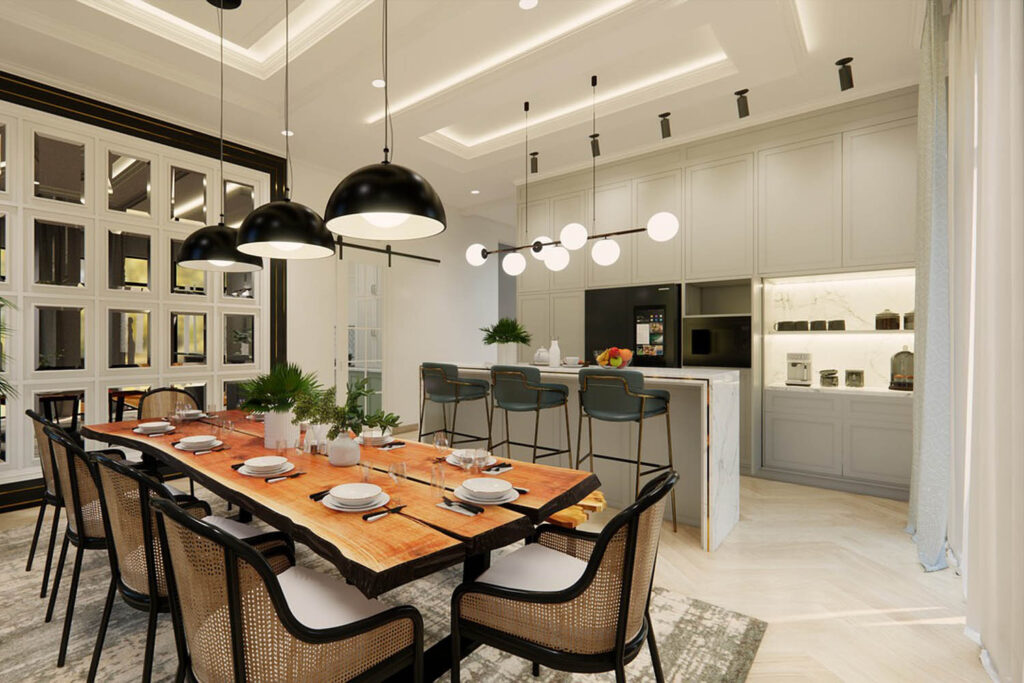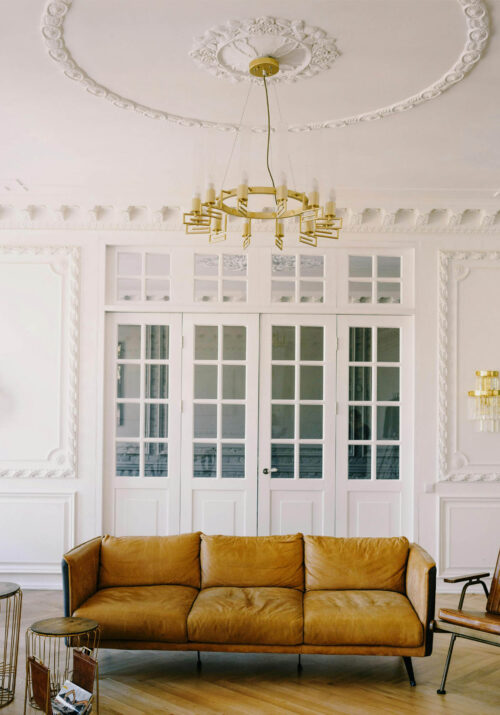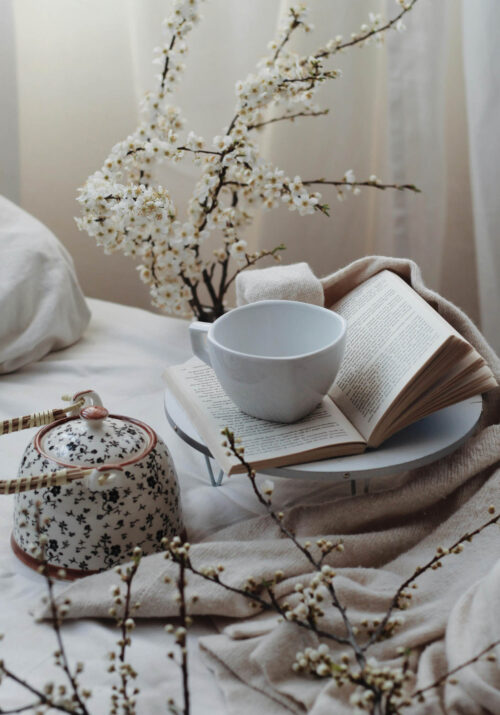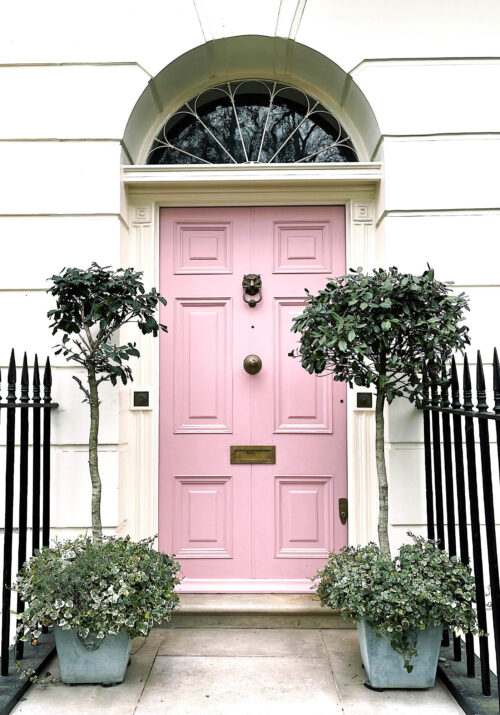Creating a well-styled interior involves more than just throwing together furniture and decor. It’s about balance, harmony, and purposeful design choices. Whether you’re a seasoned decorator or a beginner, mastering the principles of interior styling can transform your space from ordinary to extraordinary.
In this guide, we’ll explore ten key principles to help you elevate your interior styling game, focusing on editing, utilizing blank spaces, creating focal points, and mastering shelf styling.

Edit with Purpose
When editing your space, focus on removing clutter and non-essential items that detract from the overall aesthetic. For example, consider decluttering countertops by storing kitchen appliances out of sight or minimizing the number of decorative objects on display.
Prioritize furniture pieces that serve a dual purpose, such as ottomans with hidden storage or coffee tables with built-in shelves, to maximize functionality without sacrificing style. Invest in organizational solutions, such as baskets, bins, and shelving units, to keep items neatly stored and out of sight when not in use.
Embrace Blank Spaces
To embrace blank spaces effectively, resist the urge to fill every inch of wall space with artwork or adorn every surface with decor.
Instead, leave areas of wall space empty to create visual breathing room and draw attention to key focal points. Opt for minimalist furniture with clean lines and streamlined silhouettes to enhance the sense of openness and simplicity in your space. Use area rugs to define zones within an open floor plan while still allowing for negative space around furniture groupings.
Create Focal Points
To create a focal point, consider using a bold statement piece of furniture, such as a vibrant sofa or a sculptural accent chair, as the centerpiece of the room. Frame artwork or a large mirror with sconces or decorative wall molding to draw attention to the wall and create a focal point. Arrange furniture around the focal point to create a cohesive layout that directs the flow of traffic and encourages conversation.
Incorporate accent lighting, such as pendant lights or track lighting, to spotlight the focal point and add depth to the room.
Understand Scale and Proportion
To achieve proper scale and proportion, measure your space and furniture dimensions carefully before purchasing or arranging items.
For example, opt for a sectional sofa in a large living room to anchor the space and provide ample seating without overwhelming the room’s proportions. Use rugs to define seating areas and ensure that they are large enough to accommodate all furniture legs or extend slightly beyond the furniture footprint.
Balance the scale of furniture with smaller decorative accents, such as throw pillows, vases, and tabletop decor, to create visual interest and prevent the space from feeling monotone.
Play with Texture and Contrast
Experiment with mixing textures by layering different materials, such as velvet upholstery, leather accent chairs, and rattan baskets, to add visual depth and tactile interest to your space.
Contrast matte and glossy finishes, such as matte black hardware against glossy white cabinetry in the kitchen, to create visual intrigue and highlight architectural details. Incorporate contrasting colors, such as pairing warm wood tones with cool metal accents, to create a dynamic color palette that pops against neutral backgrounds.
Keep reading to uncover the art of interior styling with these 10 principles, covering everything from editing to embracing blank spaces, crafting focal points, and perfecting shelf styling for a truly captivating space.
Incorporate Personal Touches
Infuse your space with personal touches by displaying cherished heirlooms, such as vintage photographs or handmade quilts, on open shelving or gallery walls. Incorporate pieces of artwork or decorative accents that reflect your hobbies and interests, such as travel souvenirs or sports memorabilia, to add personality and warmth to your space.
Consider customizing furniture or decor pieces with meaningful details, such as monogrammed throw pillows or engraved picture frames, to create a sense of connection and nostalgia.
Balance Symmetry and Asymmetry
To achieve balance with symmetry and asymmetry, pair symmetrical furniture arrangements, such as matching armchairs flanking a fireplace, with asymmetrical decor elements, such as a cluster of varied-sized art prints on one wall. Mix and match furniture styles, such as pairing a contemporary sofa with vintage side tables, to create visual interest and a sense of eclecticism.
Incorporate asymmetrical accessories, such as irregularly shaped mirrors or asymmetrical pendant lights, to break up the monotony of symmetrical arrangements and add a touch of whimsy.

Pay Attention to Lighting
To enhance the lighting in your space, layer different types of lighting sources, such as overhead fixtures, task lighting, and ambient lighting, to create depth and dimension. Install dimmer switches to adjust the brightness levels according to the time of day and mood desired.
Use lamps with adjustable arms or shades to direct light where it’s needed most, such as over reading nooks or workspaces. Incorporate natural light by strategically placing mirrors to reflect sunlight and brighten dark corners, creating the illusion of a larger and airier space.
Master Shelf Styling
When styling shelves, vary the heights and orientations of objects to create visual interest and balance.
For example, mix vertically stacked books with horizontally displayed decorative objects and artwork to add dimension and movement to the shelves. Incorporate greenery, such as potted plants or fresh flowers, to bring life and color to the display and soften the lines of the shelves. Use trays or baskets to corral small items and prevent clutter while adding texture and visual contrast to the arrangement.
Trust Your Instincts
As you experiment with different design elements, pay attention to how they make you feel and trust your instincts to guide your decisions.
Don’t be afraid to break conventional design rules and think outside the box to create a space that reflects your unique personality and lifestyle. Take inspiration from design trends and ideas but adapt them to suit your preferences and the specific needs of your space.
Remember that interior styling is a journey of self-discovery and creativity, so embrace the process and enjoy the opportunity to express yourself through your home decor.
In conclusion, mastering interior styling is a journey that requires patience, practice, and a keen eye for design.
By following these ten principles – from editing with purpose to mastering shelf styling – you can create spaces that are not only visually stunning but also functional and reflective of your personality. Remember to embrace blank spaces, create focal points, and pay attention to scale, texture, and lighting.
With a bit of creativity and confidence, you can transform any room into a beautifully styled sanctuary.











